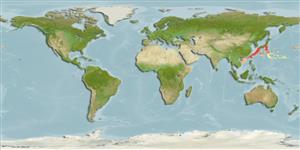Environment: milieu / climate zone / depth range / distribution range
Écologie
marin bathydémersal; profondeur 500 - 1985 m (Ref. 7460). Deep-water; 35°N - 34°S, 102°E - 153°W
Northwest Pacific: Japan and Taiwan; most probably in East China Sea and/or the Okinawa Trough, but rarely in the South China Sea. No reliable reports outside this area and need to be checked.
Taille / Poids / Âge
Maturity: Lm ? range ? - ? cm
Max length : 14.0 cm SL mâle / non sexé; (Ref. 559)
Description synthétique
Clés d'identification | Morphologie | Morphométrie
A species belonging to the C. fimbriatus species group which is distinguished mainly from its congeners by having two large pale patches on its dorsal surface, one associated with the embedded third dorsal spine and another before the origin of the soft dorsal fin; mainly four neuromasts in the lower preopercular series (vs. mainly 3 in other congeners) (Ref. 94130).
Benthic (Ref. 58302). Edible (Ref. 637).
Life cycle and mating behavior
Maturité | Reproduction | Frai | Œufs | Fécondité | Larves
Masuda, H., K. Amaoka, C. Araga, T. Uyeno and T. Yoshino, 1984. The fishes of the Japanese Archipelago. Vol. 1. Tokai University Press, Tokyo, Japan. 437 p. (text). (Ref. 559)
Statut dans la liste rouge de l'IUCN (Ref. 130435: Version 2024-1)
Menace pour l'homme
Harmless
Utilisations par l'homme
Pêcheries:
Outils
Articles particuliers
Télécharger en XML
Sources Internet
Estimates based on models
Preferred temperature (Ref.
123201): 3.5 - 6.5, mean 4.6 °C (based on 54 cells).
Phylogenetic diversity index (Ref.
82804): PD
50 = 0.5000 [Uniqueness, from 0.5 = low to 2.0 = high].
Bayesian length-weight: a=0.01122 (0.00514 - 0.02450), b=3.04 (2.87 - 3.21), in cm total length, based on all LWR estimates for this body shape (Ref.
93245).
Niveau trophique (Ref.
69278): 3.9 ±0.7 se; based on size and trophs of closest relatives
Fishing Vulnerability (Ref.
59153): Low vulnerability (10 of 100).
